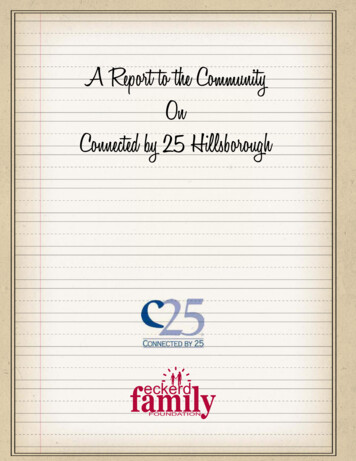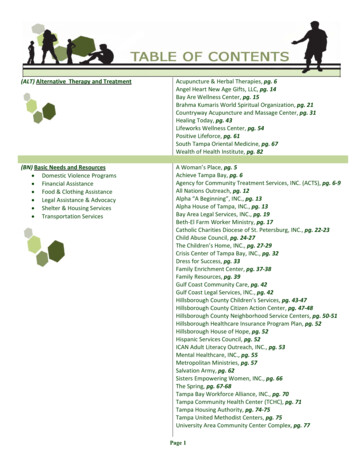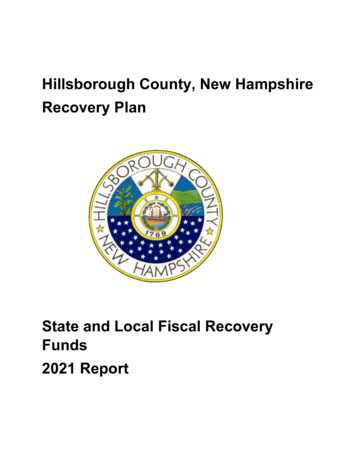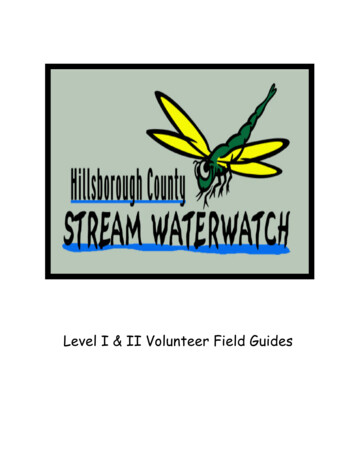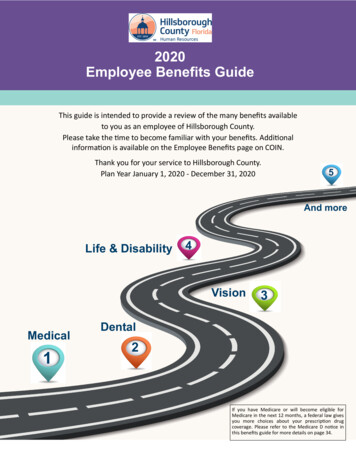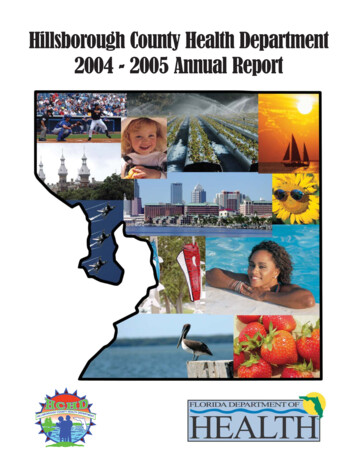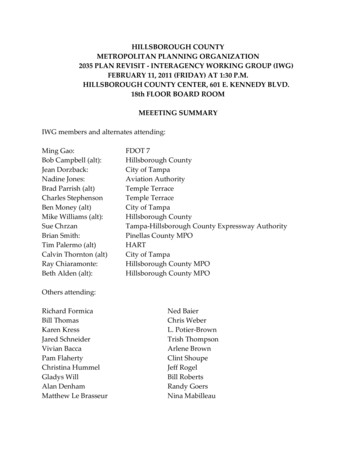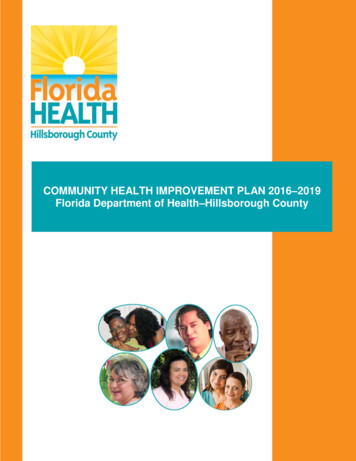
Transcription
COMMUNITY HEALTH IMPROVEMENT PLAN 2016–2019Florida Department of Health–Hillsborough County
MissionTo protect, promote and improve the health of all people in Florida through integrated,state, county, and community efforts.VisionTo be the healthiest state in the nation.Values (ICARE) Innovation – We search for creative solutions and manage resources wisely. Collaboration – We use teamwork to achieve common goals and solve problems. Accountability – We perform with integrity and respect. Responsiveness – We achieve our mission by serving our customers andengaging our partners. Excellence – We promote quality outcomes through learning and continuousperformance improvement.PrinciplesHonesty, Fairness, Devotion, Courage, and ExcellenceThis report is available at the Florida Department of Health–Hillsborough County website at:http://hillsborough.floridahealth.gov/
TABLE OF CONTENTSINTRODUCTION . 2SUMMARY OF COMMUNITY HEALTH ASSESSMENT AND RESULTS . 5ACTION PLANS . 7PRIORITY AREA 1: ACCESS TO CARE . 7PRIORITY AREA 2: BEHAVIORAL HEALTH . 9PRIORITY AREA 3: OBESITY . 11PRIORITY AREA 4.1: HEALTHY MOMS AND BABIES . 13PRIORITY AREA 4.2: HEALTHY MOMS AND BABIES . 14CHIP MONITORING PLAN . 15CHIP ALIGNMENT WITH INTERNAL PLANS AND INITIATIVES . 19CHIP ALIGNMENT WITH STATE AND NATIONAL GOALS . 21CHIP ALIGNMENT WITH PARTNERS’ PLANS AND INITIATIVES . 25APPENDIX . 26Florida Department of Health – Hillsborough CountyCommunity Health Improvement Plan 2016–2019, Version 11
INTRODUCTIONINTRODUCTIONThe Florida Department of Health in Hillsborough County (DOH–Hillsborough) completesa Community Health Assessment (CHA) and Community Health Improvement Plan(CHIP) every 3 – 5 years. The CHA was developed by DOH–Hillsborough staff with theassistance of Legacy Consulting Group. Completing the assessment involved input frommany community members and partners. The CHA included assessing the CommunityHealth Status, Community Themes and Strengths, Forces of Change, and the LocalPublic Health System to determine the health of the community. The Community HealthStatus Assessment was done using secondary data analysis from sources includingFlorida CHARTS, the US Census Bureau, and the Robert Wood Johnson Foundation.The Community Themes and Strengths Assessment was completed using primary datagathered by administering a community survey, conducting focus groups, and completingkey-informant interviews. The survey questionnaire administered to community residents,as well as the questions used to lead focus groups and key-informant interviews, areincluded in the CHA. Results from the four assessments were used to determine priorityareas for the county. The CHIP was created with action plans for partners to work on overa three year period, to address the priority areas identified in the CHA, and to improve thecommunity’s health. The completed CHA report with the background, methods,assessment results, and list of assets and resources can be found athttps://hillsborough.floridahealth.gov.The CHA and CHIP were completed using the guidelines set out in the NationalAssociation of County and City Officials’ (NACCHO’s) Mobilizing for Action throughPlanning and Partnerships Model (MAPP).Healthy Hillsborough was formed in October 2015 as a collaboration between DOH–Hillsborough, Florida Hospital, Moffitt Cancer Center, St. Joseph’s Hospitals and SouthFlorida Baptist Hospital, Suncoast Community Health Centers, Tampa Family HealthCenters, Tampa General Hospital, and Shriners Hospitals for Children – Tampa. Thecollaborative was established to complete a comprehensive Community HealthAssessment (CHA)/Community Health Needs Assessment (CHNA) and to identifyopportunities for collaboration to collectively impact and improve the health ofHillsborough County.The Healthy Hillsborough collaborative, along with more than 140 community partnersand stakeholders met on April 1, 2016 to identify priority areas to focus on for the nextthree years. During this Strategizing for a Healthy Hillsborough meeting, attendeesbrainstormed and ranked current issues facing the County to identify priority areas. The2Florida Department of Health – Hillsborough CountyCommunity Health Improvement Plan 2016–2019, Version 1
INTRODUCTIONthree Priority Areas identified include: Access to Care, Behavioral Health, and Obesity.The four themes of Encourage Healthy Behaviors, Prioritize Racial and Ethnic HealthDisparities, Improve Health Collaboration, and Address the Social Determinant of Health,were interwoven throughout the three Priority Areas and will be systematically addressedwithin a three year plan as part of the individual CHIP action plans. Figure 1 belowdemonstrates the relationship between the identified priority areas and themes. A fourthpriority area, Healthy Moms and Babies, focused on infant mortality, and was added as aresult of the Florida Department of Health’s statewide Healthy Babies Initiative. HealthyBabies is a health equity initiative that aligns with DOH–Hillsborough’s greater vision toachieve health equity in the County through addressing health disparities and the socialdeterminants of health.Healthy Babies Initiative Priority Area of FocusEncourage Healthy BehaviorsHealthyMoms andBabiesImprove Health CollaborationFigure 1: CHIP Priority Areas of FocusFlorida Department of Health – Hillsborough CountyCommunity Health Improvement Plan 2016–2019, Version 13
INTRODUCTIONTable 1: DOH–Hillsborough CHIP Priority Areas and GoalsCHIP Priority AreasGoalsIncrease access to health insurance among eligibleindividuals in Hillsborough CountyAccess to CareUnderstand transportation–related issues in accessinghealth care in Hillsborough CountyBehavioral HealthProvide the most appropriate level of care for those in needof behavioral health services in Hillsborough CountyObesityIncrease participation in Evidence–Based Interventions forobesityEliminate or reduce infant mortality by increasingpregnancy interval to greater than 18 monthsHealthy Moms and Babies4Eliminate or reduce infant mortality by raising awarenesson infant mortality and morbidity as an important healthissueFlorida Department of Health – Hillsborough CountyCommunity Health Improvement Plan 2016–2019, Version 1
SUMMARY OF COMMUNITY HEALTH ASSESSMENT AND RESULTSSUMMARY OF COMMUNITY HEALTH ASSESSMENT ANDRESULTSThe Mobilizing for Action through Planning and Partnerships Model (MAPP) model wasthe framework used for the CHA process.Community Health Status Assessment: This assessment was conducted usingsecondary data to determine the health status of Hillsborough County and compare itsperformance in relevant indicators to peer counties. In many indicator measures,Hillsborough County did not perform as well as peer counties; however, in many of thesesame measures, the County has shown improvement since the previous CHA. Notable isthe improvement in the rate of violent crime in the County. Disparities in health outcomesacross race/ethnicity can be seen in many measures including modifiable behaviors,infant mortality, and adult health.Community Themes and Strengths Assessment: Key informants mostly reported thatHillsborough County is a “great place to live” due to weather, cultural diversity, availabilityof health care providers and academic institutions. Survey participants mostly viewedthemselves and their community as being healthy; however, they noted that the cost ofhealth care and health insurance persist as barriers for those who were unable to accesshealth care. They also identified obesity, cancer, and aging problems as the mostimportant health problems facing the community. Survey respondents and focus groupparticipants answered uniquely in identifying the most important health issues currentlyfacing the community. Survey respondents did not perceive access to health care asimportantly as did the focus group participants, and they ranked obesity as the mostimportant health issue. A smaller percentage of these respondents identified obesity asthe most important health issue when compared to the percentage of focus groupparticipants who identified obesity as the most important health issue. However, focusgroup participants did not mention mental health issues as very important while surveyparticipants did. And neither group identified infant health as an important issue.Local Public Health System Assessment: This involved scoring the local public healthsystem in its performance of the Essential Public Health Services. Overall, the systemscored 69.4%, indicating that the agencies and organizations that make up the systemperform a significant number of Essential Public Health Service activities. Three areasscored optimum activity level, which is the highest level of activity; however, opportunitiesfor improvement exist in the overall local public health system.Forces of Change Assessment: This assessment was conducted in April 2016 todetermine the external changes that may affect the community, and the opportunities andpotential threats that are associated with these changes. Major forces of change identifiedFlorida Department of Health – Hillsborough CountyCommunity Health Improvement Plan 2016–2019, Version 15
SUMMARY OF COMMUNITY HEALTH ASSESSMENT AND RESULTSby the Healthy Hillsborough Collaborative include: political change/policy consequences,the affordability and access to health care, social determinants of health, carecoordination and collaboration, shifts and changes in population, and the opportunity forMedicaid expansion.The results of the Community Health Status Assessment, Community Themes andStrengths Assessment, and the Local Public Health System Assessment were presentedat a community stakeholder meeting in April 2016. At this meeting, the Forces of ChangeAssessment was completed. From these four assessments, the top ten health issueswere identified with Access to Care, Behavioral Health and Obesity selected as the keypriorities. DOH–Hillsborough staff also included a fourth priority area to the CHIP, HealthyMoms and Babies. This was included to align with the Florida Healthy Babies initiative.The complete CHA report with the background, methods, assessments results, and thelist of assets and resources can be found at https://hillsborough.floridahealth.gov.6Florida Department of Health – Hillsborough CountyCommunity Health Improvement Plan 2016–2019, Version 1
ACTION PLANSACTION PLANSThe results of MAPP assessments, community discussions and a review of assets, wereused by partners to create the action plans for the CHIP. Healthy Hillsborough SteeringCommittee members serve as co–chairs and held meetings with relevant partners toidentify the goals, objectives and other components of the actions plans. This was alsodone for the Healthy Moms and Babies action plans with input from DOH–Hillsboroughstaff and the Healthy Babies Initiative workgroup. The resulting action plans are presentedbelow. Evidenced–based, practice–based, or promising practices were considered foreach action plan as well as policy and system changes needed to accomplish action stepsor objectives.Priority Area 1: Access to CareAction Plan Work Group Co–Chairs: Jenna Davis and Sonia GoodwinAction Plan Work Group Team Members: Jennifer Kotwicki, Keri Eisenbeis, and Stefanie Alt – Baycare; Allison Nguyen –DOH-Hillsborough; Artie Fryer – Hillsborough County; Jenna Davis – Moffitt Cancer Center; Laura Resendez, Sherri Gay, andSonia Goodwin – Suncoast Community Health Centers, Inc.; Tamika Powe, Kimberly Brown – Tampa General Hospital; LizaCruz Cepeda – Crisis Center of Tampa Bay; Karyn Glubis – Tampa Family Health Centers; Melanie Hall – Family HealthcareFoundationRelevant Indicators: % of individuals under 65 years old who are uninsured in Hillsborough County(200,532;17.8% in 2014 (U.S. Census Bureau Small Area Health Insurance Estimate))Goal: Increase access to health insurance among eligible individuals in Hillsborough CountySMART Objective: By September 30, 2019, reduce the percentage of uninsured individuals under 65 years old inHillsborough County by 2%.Strategy: Implement outreach and advocacy efforts for health insurance coverageAction StepsAssess current navigationresources throughoutHillsborough CountyUtilize navigators and otheroutreach workers to provideflyers and education atcommunity events abouteligibility requirements and toschedule appointments forenrollmentResponsibleTeam MembersJenna Davis,Sonia Goodwin,Melanie HallSherri Gay,Laura Resendez,Melanie HallResourcesNeededOutput(Products)Staff time, technologyInventory ofnavigationresourcesFlyers, mediaadvertising,registration fees# of eventsattended;# artEndOctober 1,2016March 31,2017April 1,2017September 30,2019Florida Department of Health – Hillsborough CountyCommunity Health Improvement Plan 2016–2019, Version 17
ACTION PLANSAction StepsCreate educational videosabout insurance andenrollment criteria informationResponsibleTeam MembersResourcesNeededAll team membersIT assistanceIdentify and increasecommunity partnerships toregister individuals for healthinsuranceArtie Fryer,Gerry SkinnerUpdate 211 to reflect healthinsurance information andpromote resource across thecommunityLiza CruzCepeda,Jenna Davis, ArtieFryer,Sherri GayReview and track the U.S.Census Bureau’s Small AreaHealth Insurance Estimates foruninsured dataJenna Davis,Sonia GoodwinOutput(Products)DateStartEndApril 1,2017April 1,2018Key partners thatutilize navigatorsInventory ofcommunitypartners;# of partners(annually)October 1,2016September 30,2019Key partnersUpdated 211resource(annually)October 1,2016September 30,2019SAHIE databaseInventory ofSAHIEuninsureddata(annually)October 1,2017September 30,2019Series ofvideosIn assessing the Access to Care action plan, the workgroup acknowledged that issuesrelated to transportation would factor into this priority area. However, a completeframework within which to address this component was not feasible. This component maybe addressed at a later time, and an additional action plan will be created to addressaccess to care focusing on transportation issues.8Florida Department of Health – Hillsborough CountyCommunity Health Improvement Plan 2016–2019, Version 1
ACTION PLANSPriority Area 2: Behavioral HealthAction Plan Work Group Co–Chairs: Christina Bastone and Karyn GlubisAction Plan Work Group Team Members: Christina Bastone, Doug Leonardo, Marsha Lewis-Brown and Gail Ryder– BayCare; Margarita Bobonis, MD and Sean Powell – Moffitt Cancer Center; Joe Bohn, PhD – USF College ofPublic Health; Glenn Currier, MD and Saundra Stock, MD – USF Morsani College of Medicine; Daragh Gibson –DOH–Hillsborough; Karyn Glubis – Tampa Family Health Centers; Sonia Goodwin – Suncoast Community HealthCenters; Mary Jane Harrington and Seema Weinstein, PhD – Tampa General Hospital; Pam Jeffre – Success 4 Kidsand Families; Dep. Stephanie Krager – Hillsborough County Sherriff’s Office; Officer Dan McDonald – Tampa PoliceDepartment; Joe Lallanilla, Melissa Powell and Roaya Tyson – Gracepoint; Barbara Macelli – Healthy Start; MarieMarino – Hillsborough County Public Defender’s Office; Marcia Monroe and Ruth Power – Central Florida BehavioralHealth Network (CFBHN); Deanna Obregon and Mary Lynn Ulrey – DACCO; Clara Reynolds – Crisis Center ofTampa Bay; Asha Terminello – ACTS; Tina Young – Project LINKRelevant Indicators: Care Coordination Model drafted.Goal: Provide the most appropriate level of care for those in need of behavioral health services in Hillsborough County.SMART Objective: By December 31, 2017, develop a Care Coordination Model for High Utilizers in Hillsborough County.Strategy: Evaluate best practices and develop a care coordination model to address the needs of high-utilizers of behavioralhealth services in Hillsborough County.Action Steps1) Identify and evaluaterelated care models &best practices2) Define high-utilizers(ensure that bothmedical and behavioralhealth issues areincluded)3) Inventory resources(including specificindividuals &organizations working onsimilar initiativesResponsibleTeam MembersHealthyHillsboroughBH WorkgroupHealthyHillsboroughBH WorkgroupRuth Power, MarciaMonroe and/or LarryAllen (for publiclyfunded resources);Need leads to identifyother non–publicresourcesResourcesNeededKey PartnersKey PartnersKey PartnersOutput(Products)StartEndCompilation of modeldescriptions, keyfeatures and criticalsuccess factors7/22/2016 9/30/2016Definition of high-utilizersis drafted and approvedby the HealthyHillsborough BehavioralHealth work-group9/30/2016 12/31/2016Resource inventorydocument with keycontact information1/1/2017Florida Department of Health – Hillsborough CountyCommunity Health Improvement Plan 2016–2019, Version 193/30/2017
ACTION PLANSResponsibleTeam MembersAction Steps4) Identify relevant data5) Select care coordinationmodel for HealthyHillsboroughHealthyHillsboroughBH WorkgroupHealthyHillsboroughBH WorkgroupResourcesNeededKey PartnersKey PartnersOutput(Products)StartEndExecutive summary ofdata to define the currentstate / need1/1/20173/30/2017Summary document todescribe the proposedcare model elements andstructure4/1/20176/30/20171) Summary documentto map the carecoordination process6) Establish care andcoordination processand protocolHealthyHillsboroughBH Workgroup2) Protocol createdKey Partners6/30/2017 12/31/20173) Protocol approved byparticipatingproviders7) Create multi–facilityreleaseMarcia MonroeKey PartnersMulti-facility releasedocument and process inplace for use6/30/2017 12/31/2017Additional Steps (if feasible)8) Identify potential funding Healthysources to partner withHillsboroughto launch county–wideBH Workgroupcoordination model pilotKey Partners &Funding Source9) Evaluate the need forawareness campaign /Develop acommunications plan tolocate people in needKey Partners10HealthyHillsboroughBH WorkgroupCounty-wide pilot projectlaunchedAwareness campaign &communications plandevelopedFlorida Department of Health – Hillsborough CountyCommunity Health Improvement Plan 2016–2019, Version 11/1/2017Ongoing1/1/20187/31/2018
ACTION PLANSPriority Area 3: ObesityAction Plan Work Group Co-Chairs: Jan Baskin; Peter Bath, PhD; Tamika PoweAction Plan Work Group Team Members: Tina Young – Project LINK, Inc.; Cindy Hardy & Allison Nguyen – DOHHillsborough; Stefanie Alt, Danielle Mauck & Elaine Oliver – BayCare Health System; Peter Bath & Mary Willis – FloridaHospital-West Region; Jan Baskin – Florida Hospital Carrollwood; Dawn Kita – YMCA; Carla Sparks & Maria Russ –Hillsborough County Public Schools; Mary Jane Harrington & Tamika Powe – Tampa General Hospital; Jamila Lepore –UF/IFAS Hillsborough Extension; Teresa Linder – Shriners Hospital for Children; Joe Bohn, PhD, MBA – University ofSouth Florida College of Public HealthRelevant Indicators: Number of Participants in Evidence-Based Interventions for ObesityGoal: Increase Participation in Evidence-Based Interventions (EBI) for ObesitySMART Objective: By September 30, 2019, increase the number of people participating in evidence-based obesityintervention programs by 10%.Strategy: Conduct outreach and education for obesity management and prevention classes and programsAction StepsInventory existing EBIobesity programs fromCY 2015 to establish abaseline by recording 1)The name of the EBIprogram; 2) theManaging Organizationof the EBI program; 3)the total number ofparticipants in the firstclass for the entire year.Inventory existing EBIobesity programs fromCY 2016 – September30, 2019 and record 1)the name of the EBIprogram; 2) theManaging Organizationof the EBI program; 3)the number ofparticipants in the firstclass; and 4) the startdate of the program.ResponsibleTeam MembersResourcesNeededOutput(Products)Obesity Work GroupThe Department ofHealth will providea template for eachcommittee memberto use to record ourinformationA template for eachcommittee memberto record theirorganizationsrelevant informationObesity Work GroupDateStartEndInventory ofPrograms andClassesJune 1,2016October 1,2016Aspreadsheetwill provideongoingprogress andadditions on aquarterlybasisOctober 1,2016September 30,2019Florida Department of Health – Hillsborough CountyCommunity Health Improvement Plan 2016–2019, Version 111
ACTION PLANSAction StepsResponsibleTeam CommitteeMembersNumber ofpartners whoare partneringwith the workgroup to helpusaccomplishthe goal(annually)October 1,2016September 30,2019Obesity Work GroupLocations foraccess points willbe needed as theybecome necessaryAccess pointsare lly)October 1,2016September 30,2019Increase healthcareprovider awareness ofwork group’s EBIObesity programs.Obesity Work Group1) DOH websiteaccess for programoriginator linkpostings, withprograms added asneeded2) A card directingpatients/participantsto the DOH websitefor access to EBobesity-focusedprograms in thecommunityCards arebeingdistributed tohealthcareproviders(yes/no;annually)October 1,2016September 30,2019Evaluate outcomesObesity Work GroupWork groupmembers andevaluation toolCompletedevaluation(annually)October 1,2017September 30,2019Develop and enhancerelationships withpartners who can helpus increase the numberof participants in EBIobesity programs.Increase the number ofaccess points for EBIObesity programs asneeded.12Obesity Work GroupFlorida Department of Health – Hillsborough CountyCommunity Health Improvement Plan 2016–2019, Version 1
ACTION PLANSPriority Area 4.1: Healthy Moms and BabiesAction Plan Work Group Chair: Ivonne HernandezAction Plan Work Group Team Members: Florida Health Baby WorkgroupRelevant Indicators: 3 Evidence-based strategies to increase access to Long Acting Reversible Contraceptives (LARC's);Host a community meeting to share findingsGoal: Eliminate or reduce infant mortality by increasing the pregnancy interval to greater than 18 monthsSMART Objective: By December 31, 2018, identify a minimum of three evidence-based strategies to increase access toLARC's.Strategy: Research/Assessment – Identifying best models and best practices that increase access to LARCsResponsibleResourcesOutputAction StepsStartTeam MembersNeeded(Products)End1) ResearchColorado andother bestpractices forincreasingaccess toLARC’sIvonne Hernandez– USF HealthUSF faculty,DOH staffA summaryidentifying anumber of bestpracticesOctober 31,2016March 31,20172) Identify aminimum of threestrategies thatincrease accessto LARCs.Florida HealthyBaby PartnersFlorida HealthyBaby Partners3 best practicesare identifiedApril 30,2017May 31,20173) Host acommunitymeeting to sharefindings withpartners who canadvocate forpolicy changes orincreasedresources and/orimplement bestpractice modelSophia Hector DOHCommunitymeeting convened.June 30,2017October 31,2017DOH staff andFlorida HealthyBaby PartnersFlorida Department of Health – Hillsborough CountyCommunity Health Improvement Plan 2016–2019, Version 113
ACTION PLANSPriority Area 4.2: Healthy Moms and BabiesAction Plan Work Group Co–Chairs: Sophia Hector, Tara SpillerAction Plan Work Group Team Members: Dr. Leslene Gordon, Sophia Hector, Allyson Sison, Noemi Padro, BonnieWatson, Dr. Ayesha Johnson, Susan Schmidt, Tara Spiller, Meghna DesaiRelevant Indicators: Implemented Social Marketing CampaignGoal: Eliminate or reduce infant mortality by raising awareness on infant mortality and morbidity as an important health issue.SMART Objective: By December 31, 2018 create a county-wide social marketing campaign to raise awareness oninfant mortality and provide education on preventative strategies to reduce infant mortality.Strategy: Social Marketing and EducationResponsibleAction StepsTeam Members1) Research to identifyany existing socialmarketingcampaigns thatraises awareness on Allyson Sisoninfant mortality andprovide education onpreventativestrategies.2) Select an existingcampaign or developa campaign3) Identify resources toimplement socialmarketing campaign4) Implement socialmarketing campaignand/or social mediacampaign14CHIP WorkgroupResourcesNeededAccess toscholarlypublications andpublicdocuments, DOHStaffDOH staffCHIP WorkgroupFundingopportunities,DOH StaffCHIP WorkgroupDOH StaffAcquired fundingfor campaignVendorOutput (Products)Summary ofexisting plansIdentifiedcampaign oragency who willdevelop acampaignList of fundingopportunitiesComplete anyapplications toacquire fundingRequest forProposalContractSocial marketingcampaignFlorida Department of Health – Hillsborough CountyCommunity Health Improvement Plan 2016–2019, Version 1StartEndOctober 1,2016March 31,2017March 1,2017July 31,2017May 1,2017June 30,2018July 1,2018December 31,2018
CHIP MONITORING PLANCHIP MONITORING PLANThe Action Plans will be monitored on a quarterly basis. Action Plan co–chairs willcomplete a monitoring tool provided by DOH–Hillsborough, at quarterly intervals. Thismonitoring tool will reflect the status of each action step within each action plan, and willtrack progress on the process and outcome indicators. Additionally, the HealthyHillsborough Steering Committee will host an annual review meeting each October toreview the progress made on the Healthy Hillsborough action plans and to makeamendments as needed. An internal DOH–Hillsborough work group will review all theCHIP action plans and annually update the CHIP report. Figure 2 provides an illustrationof the CHIP implementation and monitoring process and cycle.Figure 2: CHIP Implementation and Monitoring Process MapA sample monitoring tool is included.Florida Department of Health – Hillsborough CountyCommunity Health Improvement Plan 2016–2019, Version 115
16Florida Department of Health – Hillsborough CountyCommunity Health Improvement Plan 2016–2019, Version 1(Outcome Indicator)(Process Indicator)(Process Indicator)(Process eCurrent(Q1)Target(Year 1)Target(Year 2)Process and Outcome Indicators Quarter 1 Tracking2016–2017 Quarter 1 Report (October 1, 2016 – December 31, 2016)CHIP ACTION PLAN MONITORING TOOLTarget(Year 3)CHIP MONITORING PLAN
See statusdefinitions below(Complete, OnSchedule, At Risk,Not on Schedule,Not Feasible)Action StatusDescription ofany products orresults of theaction completedduring Q1CompletedDeliverables/Outputs ofActionNames ofpartners,consultants,contractors, etc.who helpedcarry out theaction step inQ1KeyPartnersFlorida Department of Health – Hillsborough CountyCommunity Health Improvement Plan 2016–2019, Version 1Actual startdate ofaction stepdescribedActualStartDateActualfinish/enddate ofactionstepdescribedActualFinish/EndDateAny information thatwould be helpful inknowing more aboutthis action step'sprogress and activitiesin Q1Progress Notes17Not Feasible Action Step has been excluded from the Action Plan.Not On Schedule It looks like the Action Step will not be met by the target date. Action Step may take longer tocomplete than originally anticipated.At Risk Action Step needs some attention; milestones in action step are maybe being met, but results are not asanticipated.On Schedule No changes/delays and no scope changes.Complete Action Step is complete on or after the target date.6. 2.1.Action StepAction Steps Quarter 1 TrackingCHIP MONITORING PLAN
18Additional comments on the overall progress of action plan activities during Q1. Example notes include: partnercontributions, facilitating factors of success, barriers/issues encountered, plans to overcome barriers/issues,unanticipated outcomes, and overall progress and comments.Additional Progress and CommentsAdditional Progress and Comments Quarter 1 TrackingCHIP MONITORING PLANFlorida Department of Health – Hillsborough CountyCommunity Health Improvement Plan 2016–2019, Version 1
Florida Department of Health – Hillsborough CountyCommunity Health Improvement Plan 2016–2019, Version 1ObesityBehavioralHealthAccess to CareCHIP PriorityAreaTBDEvaluate best practicesand develop a carecoordination model toaddress the needs ofhigh-utilizers ofbehavioral healthservices in HillsboroughCounty.Conduct outreach andeducation for obesitymanagement andprevention classes andprograms.Provide themostappropriatelevel of carefor those inneed ofbehavioralhealthservices inHillsboroughCounty.IncreaseParticipation inEvidenceBasedInterventionsfor Obesity.Increase outreach andadvocacy efforts forhealth insurancecoverage.Increaseaccess tohealthinsuranceamong eligibleindividuals ed issuesin accessinghealth care oughStrategic Plan: LongHealthy Life.By September 30,2019, increase thenumber of peopleparticipating inevidence-basedobesity interventionprograms by 10%.TBDN/AAlignment withDOH-HillsboroughPlansBy December 31,2017, develop a CareCoordination Modelfor High Utilizers inHillsborough County.TBDBy September 30,2019, reduce thepercentage ofuninsured individualsunder 65 years old inHillsborough Countyby 2%.ObjectiveCHIP ALIGNMENT WITH INTERNAL PLANS AND INITIATIVESCHIP ALIGNMENT WITH INTERNAL PLANS AND INITIATIVES19
20HealthyMoms andBabiesCHIPPriority AreaBy December 31, 2018, identify aminimum of three evidence-basedstrategies to increase access toLARC's.Research/Assessment –Identifying best modelsand best practices thatincrease access to LongActing ReversibleContraception (LARC's)
The Florida Department of Health in Hillsborough County (DOH-Hillsborough) completes a Community Health Assessment (CHA) and Community Health Improvement Plan (CHIP) every 3 - 5 years. The CHA was developed by DOH-Hillsborough staff with the . Priority Area 1: Access to Care Action Plan Work Group Co .
